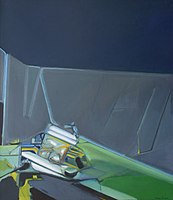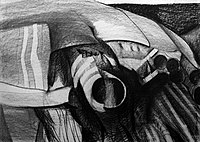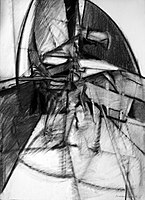Miroslav Štolfa
Miroslav Štolfa (born August 11, 1930 in Brno ; † February 26, 2018 there ) was a Czech painter and graphic artist .
Life
After successfully passing his Abitur (at the secondary school in Vranovská Street in Brno-Husovice ), Miroslav Štolfa studied art education at the Faculty of Education at Masaryk University (with Eduard Milén, BS Urban and Vincenc Makovský) and at the from 1949 to 1953 History Faculty of Philosophy (with Ferdinand Stiebitz, Josef Macůrek and Rudolf Holinka).
After completing his studies, Štolfa turned his attention to painting and teaching at secondary schools with an educational focus in Boskovice , Tišnov and Brno. In 1955 he married his partner Věra Zemanová; from this marriage the son Jaromír (* 1957) and the daughter Jana (* 1959) emerged. In the same year his first solo exhibition took place in the Club zaměstnanců školství (Club of School Employees) in Brno.
In 1963, Štolfa appeared as a co-founder of the Parabola artists' association , to which a number of important Brno artists had joined (Antonín Čalkovský, Rudolf Fila, Robert Hliněnský, Dalibor Chatrný, Jozef Jankovič, Zbraně Macháček, Eduard Ovčášan, Valseockošel Veleba, Václav Zykmund and others). The association's spokesman was the art scholar Václav Zykmund.
At that time, Štolfa was teaching at the chair for art theory and education at the Philosophical Faculty of the Palacký University in Olomouc . In 1966 he completed his habilitation in this subject. In the 1960s he made several study trips abroad (Belgium, France, Italy, the Netherlands, Hungary, Germany, Poland, Austria and Spain). From 1978 to 1983 he taught drawing and painting at the Chair of Aesthetic Education at the Faculty of Education at the Jan Evangelista Purkyně University in Brno. At the age of 53 he left the pedagogical career and from then on devoted himself exclusively to his own artistic work.
In 1990, Štolfa co-founded the TT klub artists' association, in which representatives of the 1950s generation and some art theorists were also active (R. Horáček, J. Valoch, I. Zhoř). In 1992 he took part in the establishment of the Institute of Fine Arts in the Faculty of Architecture of the Technical University in Brno and until 1993 he headed the newly established painter's studio .
Štolfa's œuvre includes an extensive collection of paintings and drawings that are based on a profound knowledge of avant-garde trends. During his life he realized 50 solo exhibitions and took part in 170 collective exhibitions, more than 70 of them abroad. Miroslav Štolfa lived and worked in Brno.
plant
Štolfa painted from early childhood and was interested in the Brno periphery with the marshalling yard , Masaryk ring and the unspoilt landscape of the Vysočina region , from which his family comes. During his studies he was influenced by Group 42 and the Cubist movement.
In his first creative phase, Štolfa painted inconspicuous corners of the city of Brno with subdued colors, but soon his affinity for machines and technology in general gained the upper hand, which is also reflected in the paintings of the 1950s and 1960s. At that time he was fascinated by the ambience of motorcycle races and racing machines (picture cycles Die Rennfahrer , Das Depot , Der Motor ), cars and airplanes, and later also large industrial buildings (picture cycle Die Kraftwerke ). A free combination of civilizational and technical forms and symbols, which were the original theme of the picture cycles, gradually broke away from the real environment. At the end of the 1960s, his artistic work came to an abstract form of expression by exploring general relationships, forces and movements artistically.
In the 1970s, Štolfa also devoted himself to large-format black and white charcoal and ink drawings in which fictitious mechanical devices and their components were depicted. Since the early 1980s, his paintings have also shown stylized figures , for example marked by racing overalls .
In 1981, Štolfa began working on the New Nature series of paintings . In his artistic reflection, technology becomes the defining factor that helps shape the environment. The painter looks at the possibilities that technology offers people, as well as their darker side, which is accompanied by a civilization catastrophe caused by abuse. This cycle of 35 paintings was exhibited in the House of Arts in Brno in 1984, and the title “New Nature” became a commonly used term for other exhibitions dealing with civilizational themes.
In other painting cycles that have the landscape as their theme, technology is often present as an art element or metaphor . Nevertheless, this inspiration is shifted to the level of general traits and an artistic substance dominates in the paintings, which is brought to light due to more rational considerations and a keen sense (the cycles Horizonte , Ateliers , Signals , Die Kapottenlandschaften , The Movements in the Landscape , The Views ) becomes.
Since the end of the 1990s, Štolfa's work has shown a dwindling concrete reality and increasing abstraction, his pictures acquired a meditative character, referring to depressing aspects of human existence ( The Sacrifice , 2002, Memento , 2007), brought feelings of loneliness ( Der Einsiedler , 2009) or let the theme of a rebellion and a fall ( The Story of Icarus , 2011) resonate.
Štolfa's work is a comprehensive testimony to the aspects of technical civilization, from hope and admiration to negative consequences for the environment, loss of illusions and feelings of alienation . With the inclination towards the meditative and the reflection of the invisible, it offers both a way out and hope for a positive outcome for today's world.
painting
drawings
Exhibitions (selection)
- 1985: II. Internazionale Symposium der Tapisserie , Graz, Coup d´oeil sur la peinture le dessin et l´art graphique de Brno , Rennes, International Spring Fair , Dubai, Osaka
- 1987: Malarstwo czeskie i slowackie (1947–1987) , Warszaw, Štětín, 20 years of the Artica Gallery , Cuxhaven
- 1988: Tapestry, pictures , TOPHAM, Vienna, art-protis tapestry , London, Basel art fair , contemporary painting from South Moravia , Altenburg
- 1989: The small format , G. Artica, Cuxhaven
- 1990: Contacts 1990 , Grieskirchen
- 1991: The Days of Czechoslovak Culture , Spiesertor Gallery, St. Gallen
- 1991/1992: Nová příroda / New Nature / Új Természet , Knoll Gallery Budapest, Natural History Museum Vienna , Sýpka-Vlkov Gallery
- 1992/2003: Minisalon , Galerie Nová síň, Praha, New York, Hollywood, Cincinnati, Chicago, Indianapolis, Rapids, Albuquerque, Forth Myers, Columbia, North Dartmouth, St. Petersburg, Brusel, Surabaya, Jakarta, Ubud, Paris
- 1997: Knowledge of the context , Museum Bochum
- 2000: Donations , Museum Bochum
- 2002: La Bohéme at Voiture , Mulhouse, France
- 2007: The exhibition of the TT Club , Künstlerforum, Bonn
literature
- Miroslav Štolfa , Gabrielová B et al., 1997, Moravská galerie v Brně, monograph, č., En., 127 p., 102 phot., ISBN 80-7027-059-4 .
- Miroslav Štolfa , Jaroslav Malina (eds), Jiří Hlušička, monograph 255 s., Akad. Verlag CERM, Brün 2017, ISBN 978-80-7204-965-3 .
Web links
| personal data | |
|---|---|
| SURNAME | Štolfa, Miroslav |
| BRIEF DESCRIPTION | Czech painter and graphic artist |
| DATE OF BIRTH | August 11, 1930 |
| PLACE OF BIRTH | Brno |
| DATE OF DEATH | February 26, 2018 |
| Place of death | Brno |
















